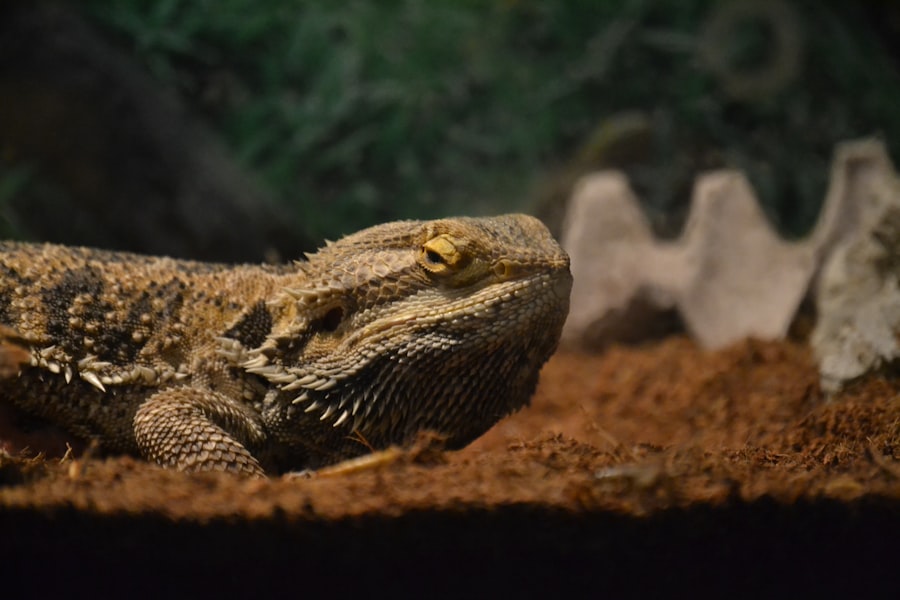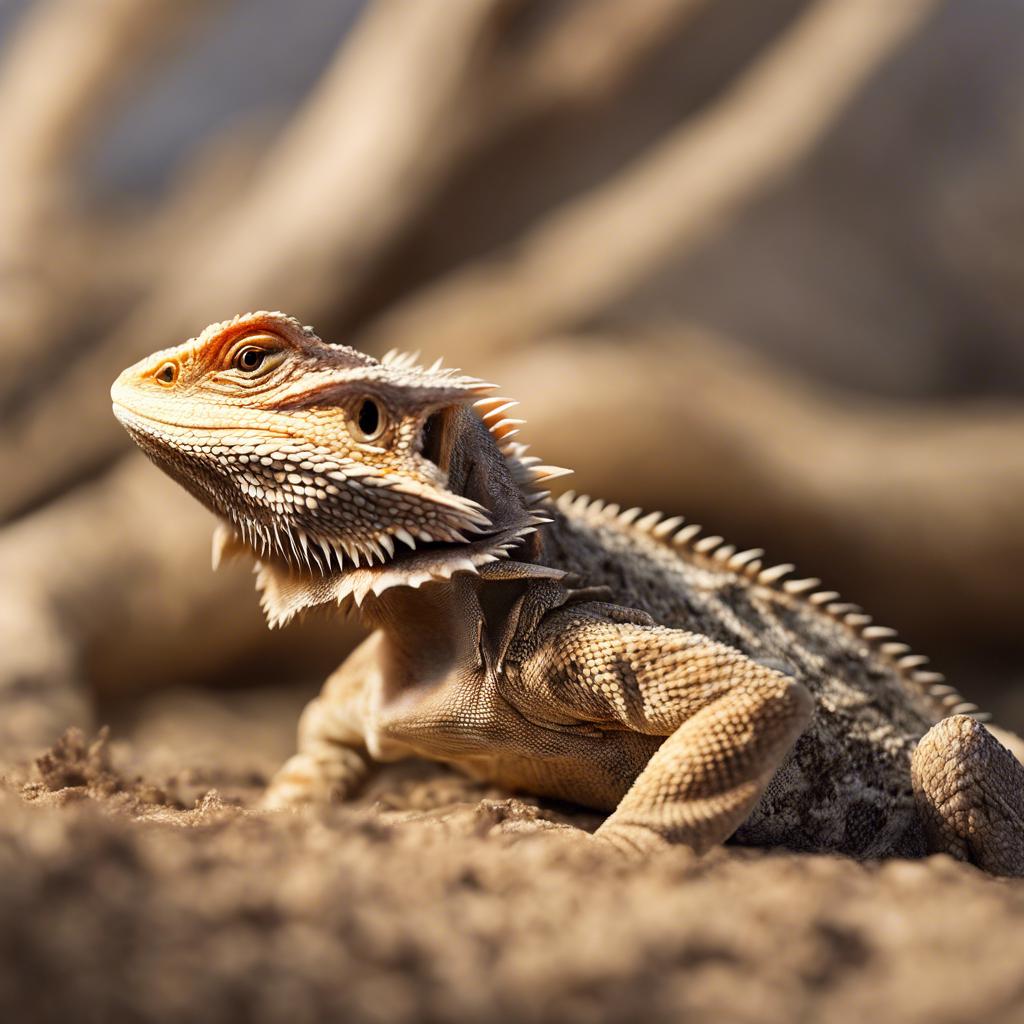Bearded dragons, scientifically known as Pogona, are a type of lizard native to Australia. They are named for the spiky beard-like scales on their throats that they can puff up and darken when they feel threatened or excited. Bearded dragons have become increasingly popular as pets due to their docile nature and unique appearance.
One of the reasons why bearded dragons make great pets is their calm and friendly temperament. They are known for being relatively easy to handle and can become quite tame with regular interaction. Bearded dragons are also known for their intelligence and ability to recognize their owners. They can be trained to do simple tricks and enjoy human interaction.
Key Takeaways
- Bearded dragons are popular pets due to their docile nature and unique appearance.
- Bearded dragons can grow up to 2 feet in length and can live up to 15 years with proper care.
- Full grown bearded dragons have distinct physical characteristics such as spiny scales and a beard-like flap of skin under their chin.
- Bearded dragons come in a variety of colorations and patterns, including citrus, hypo, and leatherback.
- Proper habitat, diet, and care are essential for the health and well-being of full grown bearded dragons.
The Growth Process of Bearded Dragons
Bearded dragons go through several stages of growth from hatchling to adult. When they first hatch, they are only a few inches long and weigh just a few grams. As they grow, they go through several molting cycles where they shed their old skin to accommodate their increasing size.
The growth rate of bearded dragons can vary depending on factors such as diet, temperature, and genetics. On average, it takes about 12-18 months for a bearded dragon to reach its full adult size. During this time, they will go through several growth spurts where they may gain several inches in length in just a few weeks.
What Does a Full Grown Bearded Dragon Look Like?
A full grown bearded dragon can reach a length of 18-24 inches from head to tail. They have a stocky build with a broad head and a long, tapering tail. The body is covered in small, rough scales that give them a unique texture.
In terms of weight, adult bearded dragons can range from 300-600 grams, with males typically being larger and heavier than females. Their size and weight can also vary depending on factors such as diet and genetics.
Physical Characteristics of Full Grown Bearded Dragons
Bearded dragons have a unique body structure that sets them apart from other lizards. They have a triangular-shaped head with a row of spiky scales along their throat, which they can puff up to make themselves look larger and more intimidating.
Their bodies are covered in small, rough scales that provide protection and help regulate their body temperature. Bearded dragons also have sharp claws on their feet, which they use for climbing and digging.
One of the most distinctive features of bearded dragons is their ability to change color. They can darken or lighten their skin depending on their mood, temperature, or environment. This color change is most noticeable in the beard area, where they can display vibrant patterns and hues.
Coloration and Pattern Variations of Bearded Dragons
Bearded dragons come in a wide range of colors and patterns, making each individual unique. The most common color variation is the classic “normal” or “wild type,” which consists of shades of brown and tan with darker markings.
In addition to the normal coloration, there are also several morphs or genetic variations that result in different colors and patterns. Some popular morphs include citrus, hypo, translucent, and leatherback. These morphs can result in bearded dragons with vibrant oranges, yellows, reds, or even pastel shades.
Identifying different patterns in bearded dragons can be a fun challenge for enthusiasts. Some common patterns include tiger stripes, banded patterns, and even spots or blotches. These patterns can vary in intensity and coverage, creating endless possibilities for unique and beautiful bearded dragons.
Habitat and Living Conditions of Bearded Dragons

Creating the ideal living conditions for your bearded dragon is crucial for its health and well-being. Bearded dragons are native to the arid regions of Australia, so they require a warm and dry environment.
A suitable habitat for a bearded dragon should include a spacious enclosure with proper lighting, heating, and ventilation. The enclosure should have a temperature gradient, with a basking spot that reaches around 100-110 degrees Fahrenheit and a cooler area around 80-85 degrees Fahrenheit. It is also important to provide a UVB light source to ensure proper calcium absorption.
The enclosure should be furnished with branches, rocks, and other climbing structures to provide enrichment and exercise for your bearded dragon. A substrate such as reptile carpet or ceramic tiles can be used on the floor of the enclosure for easy cleaning.
Diet and Nutrition for Full Grown Bearded Dragons
Proper nutrition is essential for the health and longevity of your bearded dragon. In the wild, they are omnivorous, meaning they eat both plant matter and insects. As pets, their diet should consist of a variety of vegetables, fruits, and insects.
Leafy greens such as collard greens, mustard greens, and dandelion greens should make up the majority of their vegetable intake. Fruits such as berries, melons, and apples can be offered in moderation as treats. Insects such as crickets, mealworms, and dubia roaches should also be included in their diet to provide essential protein.
It is important to dust the insects with a calcium supplement before feeding them to your bearded dragon to ensure they are getting enough calcium. Bearded dragons also require a source of UVB light to properly metabolize calcium.
Common Health Issues in Full Grown Bearded Dragons
Like any pet, bearded dragons can experience health issues from time to time. Some common health problems in bearded dragons include metabolic bone disease, respiratory infections, parasites, and impaction.
Metabolic bone disease is a condition that occurs when a bearded dragon does not receive enough calcium or vitamin D3, resulting in weak bones and deformities. Respiratory infections can occur if the bearded dragon is kept in a damp or dirty environment. Parasites such as mites or worms can also affect bearded dragons if they are not properly cared for.
To prevent and treat health issues, it is important to provide proper nutrition, maintain a clean and dry environment, and seek veterinary care if necessary. Regular check-ups with a reptile veterinarian can help catch any potential health problems early on.
Tips for Caring for Full Grown Bearded Dragons
Caring for a full grown bearded dragon requires time, effort, and dedication. Here are some tips to help you properly care for your bearded dragon:
1. Provide a suitable habitat: As mentioned earlier, it is important to create a warm and dry environment with proper lighting and heating for your bearded dragon.
2. Feed a balanced diet: Make sure to provide a variety of vegetables, fruits, and insects to ensure your bearded dragon is getting all the necessary nutrients.
3. Handle with care: Bearded dragons are generally docile, but it is important to handle them gently and avoid any rough handling that could cause stress or injury.
4. Keep the enclosure clean: Regularly clean the enclosure to prevent the buildup of bacteria or parasites that could harm your bearded dragon.
5. Monitor their health: Keep an eye out for any changes in behavior or appearance that could indicate a health issue. If you notice anything unusual, consult a reptile veterinarian.
Capturing the Beauty of Full Grown Bearded Dragons in Pictures
Bearded dragons are not only fascinating pets but also beautiful creatures to photograph. To capture great photos of your bearded dragon, consider the following tips:
1. Lighting: Use natural light or a soft artificial light source to avoid harsh shadows or reflections in your photos.
2. Composition: Experiment with different angles and perspectives to capture the unique features and expressions of your bearded dragon.
3. Background: Choose a clean and uncluttered background that will not distract from the main subject.
4. Patience: Bearded dragons can be quite active, so be patient and wait for the right moment to capture that perfect shot.
Once you have taken some great photos of your bearded dragon, consider sharing them with other bearded dragon enthusiasts. There are online communities and social media groups dedicated to bearded dragons where you can share your photos and connect with other owners who share your passion for these amazing creatures.
In conclusion, bearded dragons are fascinating pets that offer a unique combination of beauty, intelligence, and docile nature. By providing them with the proper care, nutrition, and environment, you can ensure they live a long and healthy life. So if you're looking for a pet that is both captivating and rewarding, consider adding a bearded dragon to your family.
If you're a fan of full grown bearded dragon pictures, you might also be interested in learning about their dietary preferences. Did you know that bearded dragons can eat black beans? Find out more about this intriguing topic in the article “Can Bearded Dragons Eat Black Beans?” on Reptile Wizard's website. While you're there, don't forget to check out their article on whether bearded dragons can eat black olives as well. For any further inquiries or questions, feel free to reach out to the Reptile Wizard team through their contact page. Happy exploring!
FAQs
What is a bearded dragon?
A bearded dragon is a type of lizard that is native to Australia. They are popular pets due to their docile nature and unique appearance.
How big do bearded dragons get?
Bearded dragons can grow up to 2 feet in length, including their tail. Males tend to be larger than females.
What does a full grown bearded dragon look like?
A full grown bearded dragon will have a broad, triangular head with a spiky beard under their chin. They have a flattened body with rough, scaly skin and a long tail. Their coloration can vary, but they typically have shades of brown, tan, and gray.
What do bearded dragons eat?
Bearded dragons are omnivores and eat a variety of insects, vegetables, and fruits. Some common foods include crickets, mealworms, kale, and strawberries.
How long do bearded dragons live?
Bearded dragons can live up to 10-15 years with proper care and nutrition.
Do bearded dragons make good pets?
Bearded dragons can make great pets for those who are willing to provide them with the proper care and attention. They are docile and easy to handle, making them a popular choice for families and first-time reptile owners.

